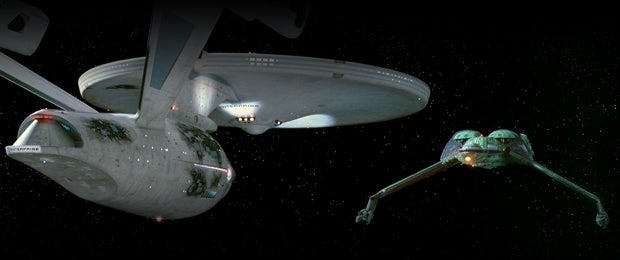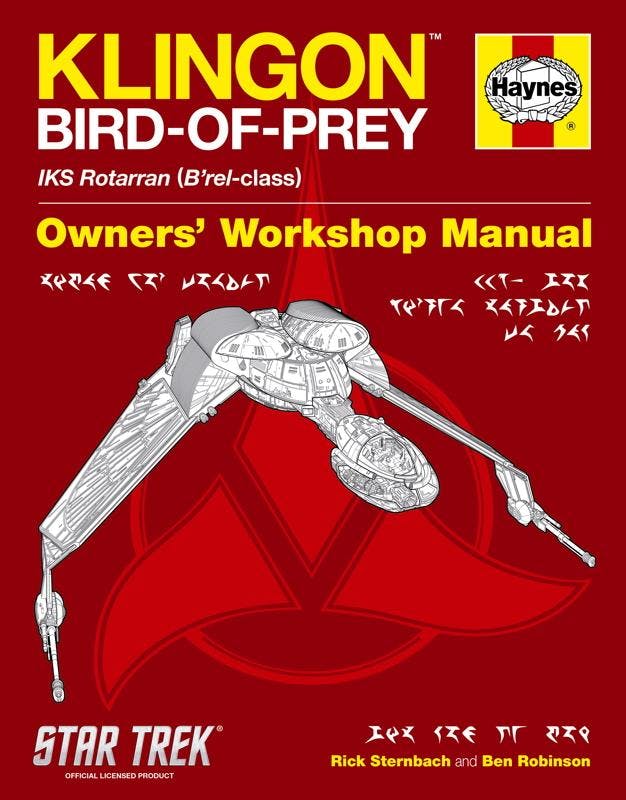Published Oct 11, 2012
Breaking Down The Bird-of-Prey With Ben Robinson
Breaking Down The Bird-of-Prey With Ben Robinson

Ben Robinson must have done something right. Robinson (and Marcus Riley) penned the U.S.S. Enterprise Owners’ Workshop Manual for Haynes Publishing back in 2010. Haynes clearly liked the results, as they’ve turned to Robinson again, this time pairing him with Rick Sternbach, to write the Klingon Bird-of-Prey Owners’ Workshop Manual. The eagerly awaited book – which features CGI renders, cutaways and other diagrams that detail the assorted model and key technologies, plus technical data cleverly interwoven into a history of operational roles – will be released in November. StarTrek.com caught up with Robinson at home in England for an interview in which he previewed Klingon Bird-of-Prey Owners’ Workshop Manual.First, what did you make of the reaction to the Enterprise Manual?Robinson: It was very flattering and it was very nice to see that it sold so well and was a success. So it was quite an interesting challenge when they started talking about, “What would we do next?” Klingon Bird-of-Prey seemed like the obvious candidate, but it was a very different situation. When you look at the Enterprise, there was a lot of information that was already out there. There’d been a Technical Manual for the Enterprise-D. There were countless episodes where the characters said, “We’re going to go to Deck… whatever,” and you’d find out a lot about how things work. Klingon ships are a bit different. People sort of stand on the bridge and kill things, and they eat a bit. So it was an interesting challenge, how we’d approach it.Your goal was to do something different from the Enterprise Manual. So, what did you learn from doing the Enterprise Manual that you brought to Klingon Bird-of-Prey Manual, and what, exactly, did you want to do differently this time?Robinson: I started working on Star Trek, God knows how many years ago. It was at least a dozen years ago, working on the Star Trek Fact Files. So I had a pretty good idea of what works well. On top of that, I think that one of the great opportunities is that, because so many effects/CG models were created for the show, you’re able to use those in publishing in a way that never used to be possible. I knew that would all work well. At the same time, as I said, I think the Enterprise book had been very much a canter through these different ships, and nothing like as detailed as I knew some people would have liked it to have been. So I wanted to create a book that had a nice balance between more technical data, but was still a bit more approachable than some of the really tech-heavy publications there have been in the past.What did you learn about the Klingons and the Bird-of-Prey from working on this?Robinson: Actually, what I learned about the Klingon is how remarkably consistent they are. There are 600-odd episodes and a lot of the Klingon episodes were written by Ron Moore. It all makes an awful lot of sense. I think when you go look at these things and you start to pick at them you think, “There are bound to be loads of contradictions, and I don’t know how we’re going to deal with that.” But, actually, there were great things about the Klingons and the more you looked at them, the more you thought, “Yeah, that makes sense. That ties up with this and that ties up with that.” Ron had used quite a lot of real-world parallels, and they were neatly slotted in there.
So, in the book we talk about the establishment of the Klingon academies, which is something Ron referenced in one of his episodes. It’s a kind of fleeting reference, and I realized this was quite similar to what Peter the Great had done in Russia. It made perfect sense that, yeah, Peter the Great had set up military academies in a feudal society, and you start thinking, “This would tie in very neatly with the way that Klingon society was arranged.” So, the main thing I learned was how consistent and coherent it was. There were things that were not entirely clear, that we had to work out, and we did.You’ve known Rick Sternbach for a long time, we understand. How involved were you with him day-to-day on this project?Robinson: I used to edit the Star Trek Magazine in the U.S. and Rick wrote stuff for me then and I interviewed him loads. So I brought him on board because I felt that if we’re going to expand on something this much, then we need somebody who really had the credibility to do that and really knows their way around. Rick was my first thought, to be honest. We talked about things on a philosophical level. One of the big problems with Klingon ships, the Bird-of-Prey in particular, is how it changes size. They’re not all the same size. We spent quite a lot of time talking about, “Well, hang on a minute. Maybe they are all different sizes, and could you just scale them up? Would shipyards be able to make them in different sizes?” We talked about that kind of thing.
When it then came to the exact workings of the warp core, for example, or of the anti-matter injection units or things like that, I left that pretty much to Rick, but then I came back through and took another pass at it and tried to make it just – I hope you’ll forgive me for saying this – a little more approachable for the average reader. Rick is incredibly sort of technically aware, but he’s so technically aware that sometimes he forgets that he’s not living in the 24th century. So we talked about it philosophically and he handled more of the really technical stuff, whereas I did more of the cultural stuff. Then I’d take another pass at the technical stuff just to make it a little easier for the less technically minded of us.What’s next for you?Robinson: I don’t have anything else right now. I think the logical thing to do, and I haven’t even said this to Haynes, would be a Starfleet shipyard. I’m actually working on a collection of small model Star Trek ships. We’re collecting all the different CG models together as reference and then producing die-cast scale-model ships. These ships, like the Akira or… you can get much more obscure, like the Equinox or the Prometheus… they’re a big part of what makes the franchise cool for people, and there’s been remarkably little done about them. So if Haynes come back and say, “That went really well. What do we do next?” I think that’s what I would suggest to them.

To pre-order your copy of Klingon Bird-of-Prey Manual click below




